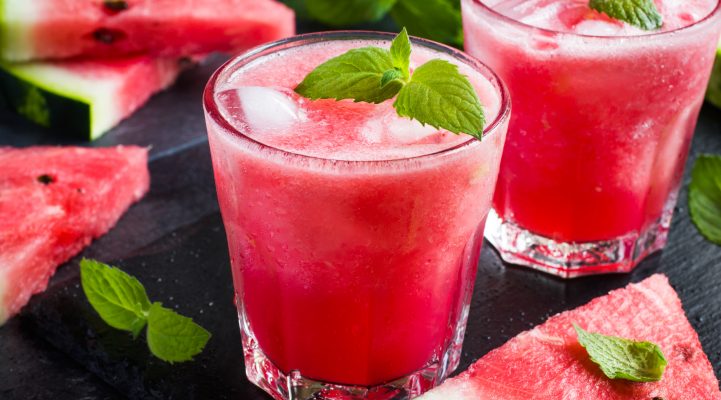The watermelon is very healthy and nutritional. How can you tell if a watermelon is ripe? How many calories does it contain? Read on to discover the answers to these questions and much more.
A South African fruit
The watermelon originally hails from South Africa, where the climate conditions are just perfect for it. Watermelons love the sun and dry, sandy ground. Even today, wild watermelons still grow in the steppes of South Africa, but they differ from the watermelons that we are familiar with in that their taste is somewhat bitter. As a result, they tend to be more popular for their seeds, which are processed for further use. Much like sunflower seeds in Europe, they are roasted and salted and enjoyed as a healthy snack; and they are also used to produce flour and oil.
How many calories are there in watermelons?
As the name suggests, watermelons contain a lot of water – about 95% to be exact – and this makes watermelons a gloriously refreshing treat, especially on hot summer days. Add to its succulence, its fruity flavour, and you have a truly delightful, almost calorie-free, taste sensation! At just 24 kcal per 100g you can enjoy watermelon to your heart’s content. What better way could there be to rehydrate yourself on a scorching hot day?
Nutritional benefits of watermelons
But watermelon has even more to offer: not only is it rich in vitamins A and C, it also contains high levels of iron and a small amount of sodium; the latter works in conjunction with the water contained within to have a cleansing effect on the kidneys. And, the watermelon seeds have a lot to offer too in terms of vitamins, minerals, fats and protein. As you can see, there’s a surprising amount packed into a watermelon!

How to tell if a watermelon is ripe
Because watermelon is such a popular fruit, it can usually be bought all year round. In Europe, it is in season during the summer months and is most readily available at this time. When you buy a watermelon, it’s a good idea to check if it is optimally ripe. Pay particular attention to its sound criteria by knocking on the watermelon. If a dull, melodious sound is produced, the fruit is ripe. If the watermelon sounds hollow and metallic, it is not ready to be eaten. Often a whole watermelon will be more than you can eat so we recommend buying half a melon – these are usually available wrapped in cling film, ready to buy. In some supermarkets, you can buy individual watermelon slices, which allows you to see exactly how ripe the fruit is. And, if you want to enjoy your fresh watermelon for as long as possible, we recommend storing it in a refrigerator where it will keep fresh for up to 27 days. In a Liebherr BioFresh-Plus compartment this period is extended by a further three days.
If your watermelon starts to taste floury within these timeframes, it will be due to its ripeness – it has simply been left for too long.
How to make a watermelon smoothie
The most common way of preparing a watermelon is to halve it, quarter it, and then cut it into slices. Its luscious red colour makes it ideal for decorating dishes. Watermelon also tastes great as a refreshing smoothie. To make your own, simply deseed 300 grams of fruit and puree it with a pot of yoghurt, 120 ml milk and 1 tablespoon of icing sugar. Then, add two scoops of vanilla ice cream and mix until creamy. Pour into glasses, decorate with mint, serve and enjoy!
What’s your favourite way to eat watermelon? Tell us about your favourite creations. Use the comment function below this post or start/join in discussions with us on Facebook.